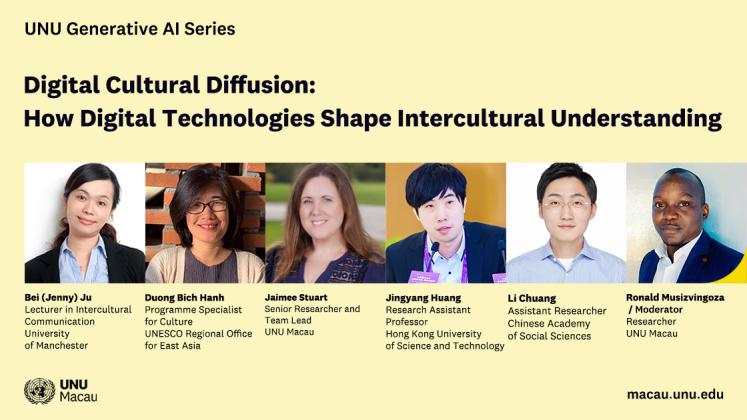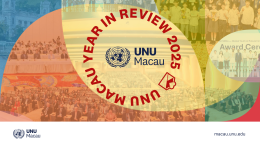On October 29th, 2024 UNU Macau organized the webinar, Digital cultural diffusion: How digital technologies shape intercultural understanding in collaboration with Tencent. The webinar hosted a moderated panel discussion from five eminent researchers and practitioners; Dr Jingyang Huang, Dr Li Chuang, Dr Jenny Ju, and myself Dr Jaimee Stuart (presenter details below). Dr Ronald Musizvingoza moderated the session.
The full recording of the webinar is available here.
Approximately 67% of the global population, equating to around 5.4 billion people, have access to the internet1HideITU (2023). Measuring digital development: Facts and Figures 2023. https://www.itu.int/en/ITU-D/Statistics/Pages/facts/default.aspx. This means that the majority of people around the world interact with, consume, share and produce digital content – and such content is embedded with cultural worldviews, beliefs, practices and artefacts. In turn, cultural values play a pivotal role in the digital media we engage with, the platforms that we use, and the content we are exposed to2HideJackson, L. A., & Wang, J. L. (2013). Cultural differences in social networking site use: A comparative study of China and the United States. Computers in Human Behavior, 29(3), 910-921. https://doi.org/10.1016/j.chb.2012.11.024. In fact, digital media can be seen to serve as a cultural gateway; connecting diverse groups of people, disseminating cultural information, and creating spaces for online communities of people who share a cultural background or values (i.e., the digital diaspora3HidePonzanesi, S. (2020). Digital diasporas: Postcoloniality, media and affect. Interventions, 22(8), 977-993. Https://doi.org/10.1080/1369801X.2020.1718537). Through digital media traditional culture can be transmitted and preserved and new cultural expressions can be developed which has led to an emerging awareness of the importance of technology for the preservation of cultural heritage4HideLian, Y., & Xie, J. (2024). The Evolution of Digital Cultural Heritage Research: Identifying Key Trends, Hotspots, and Challenges through Bibliometric Analysis. Sustainability, 16(16), 7125.. Digital technologies can also foster cultural self-expression, support intercultural understanding, and disseminate the narratives and voices of traditionally marginalized groups. In this context, digital products and services enable cultural diffusion, or the spread and adoption of elements of one culture to other peoples and places. This webinar aimed to explore the dynamics of digital cultural diffusion from interdisciplinary perspectives and to highlight the impact of importance of technologies on cultural connection.
In fact, digital media can be seen to serve as a cultural gateway; connecting diverse groups of people, disseminating cultural information, and creating spaces for online communities of people who share a cultural background or values.
In the first talk from Dr Jingyang Huang, Content Globalization: How cultural economy connects I-generation between China and ASEAN, the decentralization of cultural production was discussed. Effectively, traditional media has involved a producer (generally a media company) and a consumer. While the consumer could choose which media to engage with, they were limited in these choices. However, with the emergence of new technologies and forms of interaction (especially social media), consumers have greater agency and ability to create content and to engage with the content created by other users and groups. Dr Huang suggests this has led to “The Global South no longer being a recipient of cultural globalization but also a producer”. Effectively, media and technological innovations have opened the space for an extended dialogue where a diversity of producers are able to disseminate many different cultural forms. As an example, Dr Huang discussed the case of WeTV, China's biggest online video platform, which has a large market in the ASEAN region, distributing traditional Chinese cultural media to many other consumers.
Dr Li Chuang followed with a presentation entitled “Black Myth Wukong: Synergizing Culture,Tech, and Industry – A Cultural Materialist Exploration”. The presentation highlighted a key case of technological advancement and cultural diffusion through Black Myth: Wukong, a 2024 action role playing game (ARPG) that was inspired by the Chinese novel, Journey to the West. The game is one of the fastest selling of all time and is set in a world where gamers can engage in exploration through Chinese mythology as well as cultural and natural landmarks. Dr Chuang highlighted that in Black Myth: Wukong “abstract cultural elements are transformed into perceivable, operable digital entities” and through the highly realistic and first person orientation of the game players can understand the cultural context deeply. Using these affordances of the technology coupled with the deeply engaging story, the game has established a global fan base of gamers who are interested and invested in exploration of cultural in ways they may not have been otherwise.
In Black Myth: Wukong “abstract cultural elements are transformed into perceivable, operable digital entities” and through the highly realistic and first person orientation of the game players can understand the cultural context deeply.
The subsequent presentations were given by myself, Dr Jaimee Stuart, and Dr Jenny Ju on the importance of digital technologies for groups of people who are outside of their home countries, or who live and work across cultures. In my own presentation “Intercultural Contact in the Digital Age: How Cyberspace is Changing Acculturation” I discussed how online spaces enable hybridity, such that individuals and groups may be geographically distant but able to maintain strong connections with their own cultural groups online and to balance multiple cultural domains through the affordances of technology. This allows for a reconfiguring of the notion of cultural community and for a reimagining of self across physical boundaries. A key example drawn upon was of the research I have undertaken with the Sri Lankan digital diaspora during the 2022 economic and social crisis5HideStuart (in press). The Sri Lankan Digital Diaspora: Social Media as a Tool for Peace and Conflict in Times of Crisis. Tsinghua Journal of Field Research . During this time, many Sri Lankan migrants living outside of the country had to negotiate experiences of being physically removed from the issues happening, but also being very connected due to the synchronous communications across social media. This created both opportunities and tensions whereby people were able to have up to date information, to support those within the country and to engage in anti-conflict discourse, but also this allowed for the spread of misinformation, to feelings of frustration and hopelessness.
Dr Ju, in her presentation “WeChat use among labour migrants during (cultural) adaptation” expressed similar sentiments concerning the dual functions of social media among non-resident migrant workers in Macau (SAR) China. Her research found that these groups have long working hours, as well as experience precarity, discrimination, and isolation. To relieve these experiences, individuals often turned to WeChat for social connection, support, and entertainment. However, as highlighted by Dr Ju there were “enabling yet constraining roles of social media” such that WeChat use was associated with greater emotional comfort, but also increased anxiety and that when used excessively increased distress. Furthermore, the large amount and potential inaccuracies of unofficial information acquired through social media, coupled with relatively low levels of information literacy put individuals at risk of misinformation. 6HideJu, B., Sandel, T. L., & Dai, H.M. (2023). Resilience and (dis)empowerment: Use of Social Media among Female Mainland Migrant Workers in Macao during Covid-19. SAGE Open. ,7HideJu, B., Dai, H.M., & Sandel, T. L. (2022). Struggling in Im/mobility: Lived Experience of Macao’s Mainland Chinese Migrant Laborers’ via WeChat Moments during COVID-19. Communication, Culture & Critique, 15, 489-498. ,8HideJu, B., & Sandel, T. L. (2020). Perceived Understandings of Home and Self-identity among Mainland Chinese Dual Migrants in Macao. Journal of Intercultural Studies, 41(2), 99-115. ,9HideJu, B., Sandel, T. L., & Thinyane, H. (2019). WeChat Use of Mainland Chinese Dual Migrants in Daily Border Crossing. Chinese Journal of Communication, 12(4), 377-394. ,10HideJu, B., & Sandel, T. L. (2019). Adaptation of Mainland Chinese Labour Migrants in Macao. Journal of Intercultural Communication Research, 48(3), 257-273. This research reinforces the message that I shared in my own presentation, that technology has generally positive effects on intercultural adaption due to social connection, support and coping, but that the motivations for and amount of use matter for unlocking positive as compared to negative impacts.
Technology has generally positive effects on intercultural adaption due to social connection, support and coping, but that the motivations for and amount of use matter for unlocking positive as compared to negative impacts.
In the final presentation, Dr Hanh from UNESCO gave a distinct perspective in her talk titled “Leveraging Digital Technologies for Culture as a Global Public Good”, sharing how digital technologies are used in the culture sector. Dr Hanh highlighted the very important role of the culture sector in meeting the Sustainable Development Goals, and that digital technology is a key mechanism to transform the sector in order to advance our achievement of these goals. Some examples of utilising digital technology in the culture sector included 3D scanning of heritage sites and the digitalization of music, art, and other artefacts. Notably, Dr Hanh mentioned the new initiative of UNESCO in collaboration with Interpol – the virtual museum of stolen cultural objects – aimed at raising awareness and understanding of cultural histories. Additionally, the importance of being aware of the global digital divide including who can access technologies, who is protected, and whose stories we tell through digital media were a critical component of the presentation. UNESCO underscores the importance of technology in creating and sustaining opportunities for the cultural sector including for heritage bearers, artists, and practitioners.
This webinar brought together experts from a variety of backgrounds who each shared distinct insights into culture as it plays out in, with and through digital technologies. These presentations can help us better understand the complex eco-system in which distinct groups of people interact and share their cultural worldviews and how we engage in and protect cultural heritage in our digitally interconnected world .
Suggested citation: Stuart Jaimee., "Digital Cultural Diffusion: How Digital Technologies Shape Intercultural Understanding," UNU Macau (blog), 2024-11-21, 2024, https://unu.edu/macau/blog-post/digital-cultural-diffusion-how-digital-technologies-shape-intercultural.


